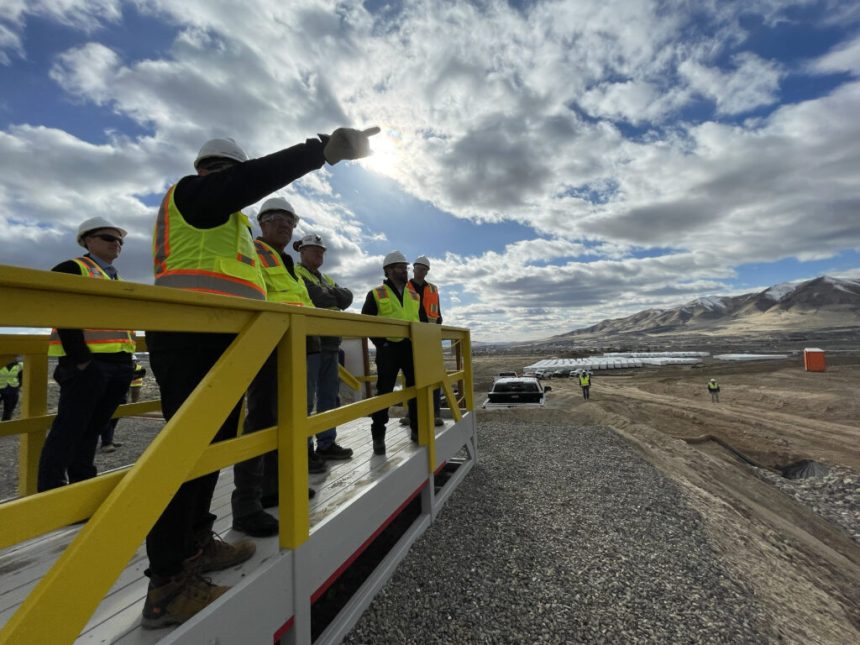The lithium industry has been hammered by falling prices in recent years due to softer demand and an oversupply of the battery metal globally, which has made mining the metal in the U.S. less attractive to investors. (Photo: Nevada Strategic Growth Initiative)
Nevada is the only state in the nation that can deliver on every phase of the lithium life cycle – from mining to recycling.
Industry experts in the state say that selling point has the potential to make Nevada a leader in the lithium battery supply chain that powers everything from electric vehicles to the data centers driving AI growth.
Nevada Gov. Joe Lombardo emphasized the importance of lithium for diversifying Nevada’s tourism-heavy economy at his second annual Nevada Lithium Summit Friday.
The lithium industry, however, has been hammered by falling prices in recent years due to softer demand and an oversupply of the battery metal globally, which has made mining the metal in the U.S. less attractive to investors.
On the second day of the lithium summit, Politico reported the Department of Energy (DOE) was reevaluating a $2.3 billion loan to the Thacker Pass lithium project, a massive proposed mine in Humboldt County near the Nevada-Oregon border. The energy agency cited the drop in price as a key factor in their rethink of the loan.
During the summit, Lombardo said the Thacker Pass lithium project – the largest known lithium deposit in North America – positioned Nevada as “a key player in both national and global supply chains.”
Thacker Pass isn’t the only lithium mine in Nevada feeling the impact of falling lithium prices. Earlier this year, mining developer Ioneer Corp. lost a $490 million investment to their Rhyolite Ridge lithium-boron project in Esmeralda County after their investing partner backed out of the project, due in part to plummeting lithium prices.
Lithium prices have fallen more than 80% since their peak in 2022, reshaping market dynamics including in Nevada. Benchmark Mineral Intelligence said average lithium fell from nearly $80,000 per tonne globally in December 2022 to about $10,000 per tonne this September. Analysts expect lithium prices to remain volatile the remainder of the year.
“Commodities ebb and flow,” said Tom Burns, the director of the Governor’s Office of Economic Development (GOED), during a press conference at the summit.
Despite falling prices, Burns said Nevada’s position as the only state in the nation with a complete “Lithium Loop” that could offer mining and processing to battery manufacturing and recycling gave the state an edge for investment.
More investment from the federal government isn’t off the table, said Burns. President Donald Trump has made reducing foreign critical mineral dependency a major priority, citing national and economic security concerns. Nevada is poised to meet that need, said Burns.
“There is movement within the federal government to support critical minerals and mining and processing as a whole,” Burns said. “I think you’ll see that in Nevada.”
“Specifically, the Department of Defense and the Department of Energy has an interest in making sure those are produced here,” Burns continued.
Nevada Battery Coalition CEO Caleb Cage said industry experts believe the growing demand for lithium and battery storage will increase and stabilize prices for the metal over the next decade.
“Looking at it long term, the remarkable demand for lithium in particular should have the market effect of adjusting that price to make some of these projects more viable,” Cage said.
“The demand for battery storage is only growing right now,” Cage said.
Growing battery storage demand has already boosted Nevada’s economy. A decade ago, about 100 people were employed in the battery manufacturing industry, according to GOED. In 2025, more than 14,200 were employed in the industry.
Manufacturing grew by about 83% in Nevada from 2015 to 2025, significantly more than the 13% national average. That growth was largely driven by the battery manufacturing industry boosted by electric vehicles and clean energy demands.
Several companies have invested in battery manufacturing and recycling facilities in Nevada, including Tesla and Redwood Materials.
Major tech companies are now also investing heavily in large AI-enabled data centers, and lithium battery storage will be a part of that, said Cage.
Electricity demand in the U.S. has continued to grow, driven in part by AI data centers that are on track to triple their share of national electricity usage from 4.4% in 2023 to 12% by 2028. Those data centers will need battery storage systems to offset power outages and reinforce the grid when demand is high or supply is limited.
Growing adoption of renewable energy sources, sustainability objectives, and need for energy efficiency is also driving the transition away from traditional lead-acid batteries to lithium-ion batteries in data centers.
In June, Redwood Materials launched Redwood Energy to build low-cost energy-storage systems that can meet surging power demand from AI data centers. The company said it’s already powering a modular data center in Sparks, Nevada for AI infrastructure company Cursoe at an energy cost lower than the grid.
“They’ve got that proof of concept out in Northern Nevada right now, and that model is going to be something that they want to replicate,” Cage said.









